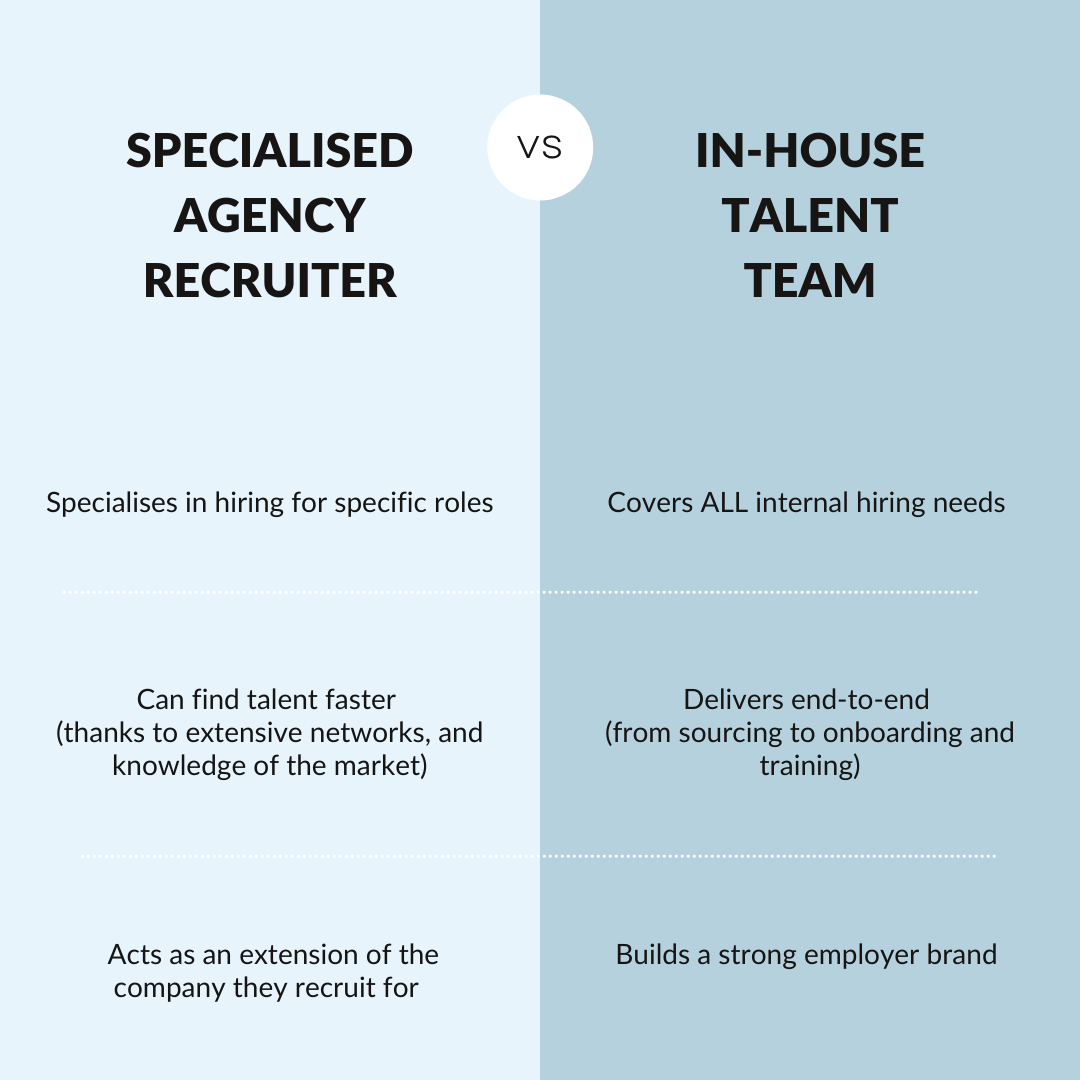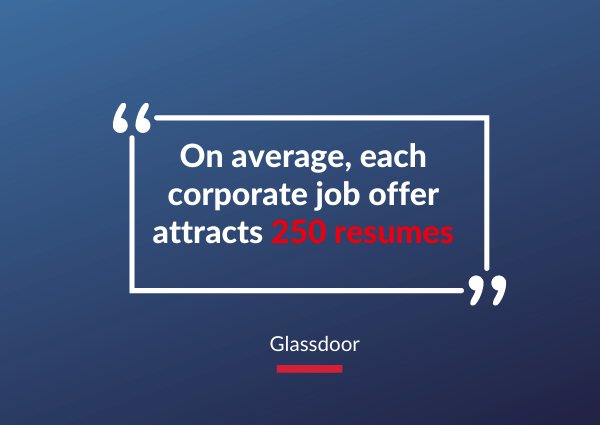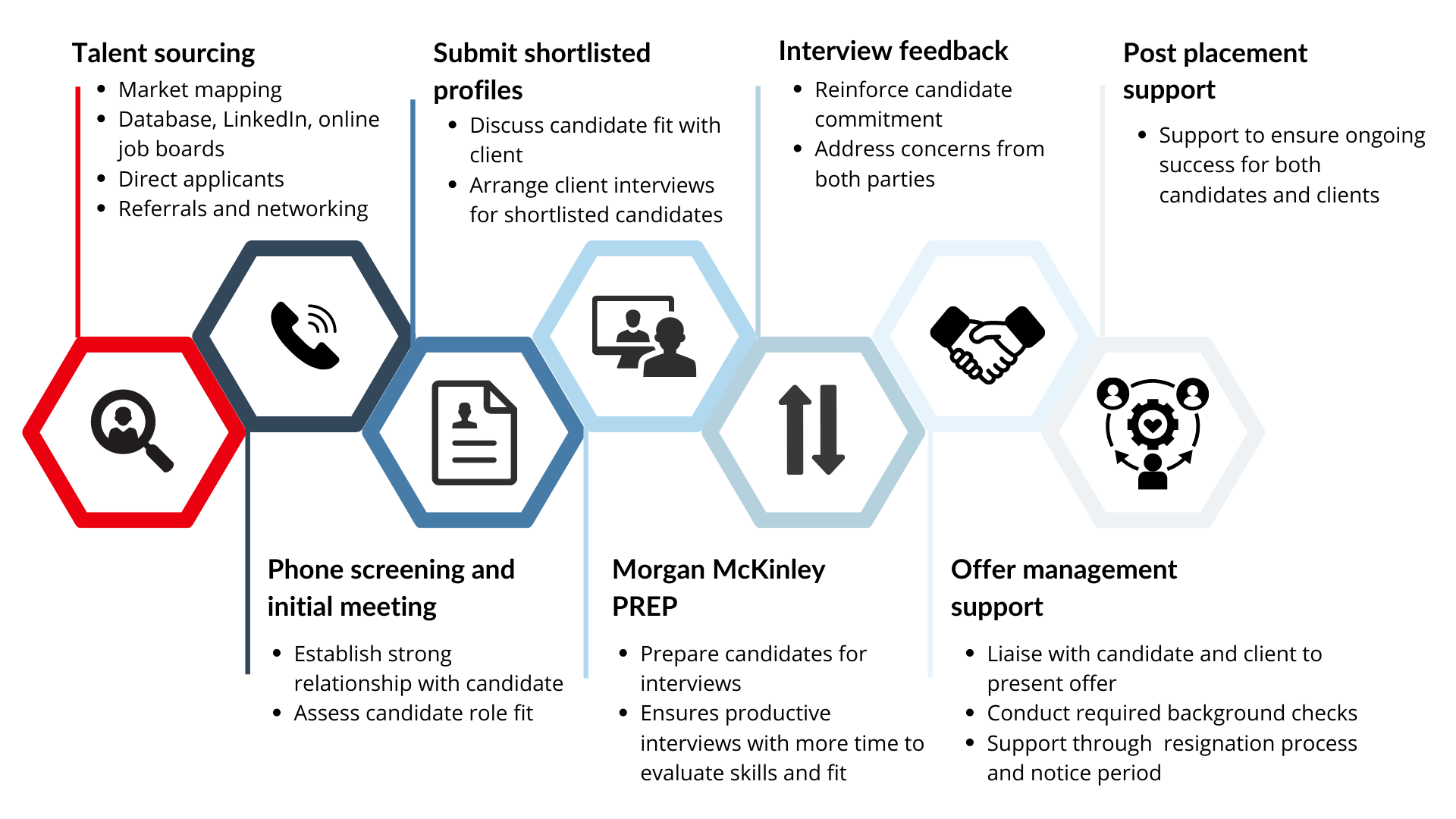Hiring Managers and Talent Acquisition teams have had it tough recently.
Through no fault of their own, they’ve had to deal with rejections, counter offers and candidates dropping out of the process even after signing the contract.
“It’s hard to hire the best people right now. You need to plan for success and work with all the resources you have at your disposal to get results.”
Dominic Bareham, Managing Director of Morgan McKinley Australia
Fortunately, we’ve got the information you need to successfully attract the right people in the current climate.
What is recruitment and what is not?
Firstly, let’s cover the basics of what recruitment actually is and where some terminology can become confusing.
When you need to hire a new team member or multiple employees, there are a few different approaches to recruitment that you can take.
Recruitment vs Talent Acquisition
Recruitment is typically when you need to fill a vacancy (i.e. if someone has left, or if you need a certain new skill set), whilst talent acquisition is more about creating an efficient and productive strategic process that enables you to continually find the people and skills to future-proof your business.
Recruitment agencies often have the people and tools to help with both approaches.
Recruitment vs Staffing
Staffing differs from recruitment in that it is often about finding an individual, or multiple people, to fulfil a short-term, immediate requirement (i.e. if you need more people to help with current or upcoming demand) as opposed to spending time finding and hiring someone with specific skills on a permanent basis.
Staffing shouldn’t be confused with contract recruitment, which is often the choice for businesses that have projects coming up which require specialist experience and expertise.
Using a Recruitment Agency vs In-house Talent team
If your organisation likes to handle things internally and hires enough people every year to warrant having someone (or a team) dedicated to it, then you may well have an in-house talent team.
This team will probably consist of a Hiring Manager who helps different departments across the business when they need to make a hire.
Whilst this can be beneficial as they see the day-to-day running of the business, are invested in your Employee Value Proposition (EVP) and know the right sort of people the teams will be looking for. However, they can sometimes lack experience of finding specialist talent and people who are not actively looking for a new role (passive candidates).
For example: Sourcing, interviewing and hiring a Software Developer is a vastly different process compared to finding a Finance Manager. What’s important to a Software Developer in a new role (e.g. working with the latest technology) might not be as important to a Finance Manager (who might put more focus on salary or career development). This is where recruitment agencies can really support your internal team.

Working with a recruitment agency will give you an external perspective on not only your potential new employees, but your hiring process as a whole - this places more of a focus on the candidate experience, which is incredibly important at the moment (if you read on you’ll find out more about this…).
They will have whole teams who specialise in specific industries, so they have extensive networks, know what to look out for in your ideal candidate’s profile, and understand exactly what motivates professionals in that area. This is something that should not be taken for granted.
More often than not, especially in bigger organisations, the in-house talent team will work closely alongside recruitment agencies in order to better solve their talent issues. That way they get the best of both worlds: the insider knowledge from your Talent Acquisition team and the industry specific expertise from your chosen agency.
The recruitment agency that works best for and with you as a hiring manager will depend on what industry you’re hiring in, your size/budget and what you are trying to achieve through making the hire(s).
What are the different stages of a recruitment process?
Now it’s time to get into the specifics of what makes up your hiring process and how to improve your recruitment and selection process.
Identifying the need to hire
There may be a range of different reasons that cause you to commence a recruitment process. You might need to respond to changes in your market, increase the speed at which your company can transform, solve a problem or simply replace a recent leaver.
Whatever your reasons are, and once you’ve figured out the type of hire that you need to make, you’ll be keen to start the process as soon as possible.
At this point you should work out how much you’re willing to pay and calculate a starting salary for the successful applicant accordingly, and then think about what to include in your job advert.
Creating the best advert for your vacancy
You will already have a job description written up for the role(s) (and if not you can use some of our job description templates), but if you want lots of people to view (and hopefully apply to) your vacancy, then you’ll need to write a job advert.
Note: If you’re using a recruitment agency, they will do this part for you.

A well written, inclusive job ad will not only help you attract talented professionals from diverse backgrounds to apply, but it will also promote your company’s brand and allow you to build a strong talent pool of potential candidates for the future.
The best thing you can do at this stage is to put yourself in the position of your ideal new hire; What would you want to see on an advert for your next job? What type of language resonates with you? What information will pique your interest?
Opinions are polarised when it comes to deciding whether or not to include the salary in your job ad - the choice is yours. What we will say, though, is that the world is definitely moving towards greater pay transparency.
Sourcing the talent
Rather than waiting for job seekers to apply to your vacancy (who may or may not be right for it), many businesses like to take fate into their own hands and actively source talent.
But you can easily end up spending hours every day trawling through LinkedIn and other suitable talent sourcing tools.
For that reason, many businesses look to a recruitment agency for help. They are often fully equipped with the best tools (which they pay a premium to use), know what tempts passive job seekers to apply for roles, and have existing networks of professionals in your industry.
It’s those long lasting relationships between recruiters and professionals, as well as businesses, that ensure the right recruitment consultant will help you find the right talent quickly, efficiently and will act as an extended arm of your business.
For example: Morgan McKinley employees all have access to LinkedIn Recruiter, which speeds up searches and enables efficient talent pipeline management.
Identifying potential people to fill your vacancy is a big step in the recruitment process; it’s time to create a shortlist of appropriately skilled professionals!
Screening your applicants
You have a list of people who have either applied to your advert or have been picked out by your Hiring Manager/the recruitment agency you have chosen to partner with.

The type of job and your specific requirements will heavily impact how straightforward this screening stage is.
A simple skim through of applicants’ CVs will reveal any who simply aren’t qualified for the role - these are mostly going to be from job board applications. Next you should create a checklist when reviewing CVs of the absolute minimum requirements, around skills, experience and education.
Once you have got down to a concise list, you can take a more thorough approach to reviewing. The final selection will all be people you invite for an interview.
A good recruitment agency will only send a shortlist of highly qualified candidates that have been pre-vetted. This means that as a hiring manager you will only meet with candidates that fully match your requirements.
Conducting interviews for your new hire

Most people see the interview stage as the most important part of the overall recruitment process. Knowing how to conduct an interview properly is integral to leaving a positive impression on your prospective new employee.
“Get organised and have your interview process nailed down. Aim to have it done in 2-3 weeks from date of application. This will get you top talent. There is a lot to be said about a company if their interview process is messy and long.”
Ian Kinsella, Managing Director of Morgan McKinley Canada
- Organise logistics of who will greet them and where the interview will take place well in advance. Is it going to be in-person, or a remote interview? If the latter, then ensure all technology is properly set-up for both sides.
- Figure out the type of interview you want to hold and work out what questions to ask - this will depend on what you are trying to assess.
- Be well prepared with a strong pitch about your company and the value the right person will bring.
- Take thorough notes - they will be invaluable when comparing multiple interviewees after the discussions have concluded.
- Confirm next steps - it is a competitive hiring market and they will likely have multiple opportunities on the go, so confirming the next stages will keep them interested and manage their expectations.
Don’t forget: This is the applicant’s opportunity to interview you as well to identify whether your company is the right one for them to join, so be ready to answer their questions.
Selecting who you want to hire
After the interviews, you will have a better picture of which applicant you want to offer the job.
At this point, you need to move fast, proactively reach out to them, get verbal commitment, send out their offer letter, potentially deflect a counter-offer and carry out pre-employment checks - it’s a lot to sort out!
In most cases, you will have a number one choice but it always pays to have at least one backup. If you tell everyone else that they have been unsuccessful and then your first choice rejects the offer, you’ll waste time going back and starting again.
“Once you have made the decision to make an offer, produce that offer in a timely manner. With the competition for talent, any delays mean you run the risk of losing your preferred applicant and having to restart your process.”
Lionel Kaidatzis, Managing Director of Morgan McKinley Japan
Hiring your new employee and creating their contract
Even when they have ‘accepted’ your offer, they are still not fully confirmed as your new employee. That only comes once they have signed and returned the contract.

An employment contract of any format is required to legally protect the employee, as well as the employer. Alongside this, it will outline what the chosen individual must do in order to do the job effectively and the company’s commitments to them as a member of staff.
There may be aspects of the contract that your applicant wants to discuss, such as annual leave and the benefits they will receive. Entering into an employment contract negotiation with them may seem irritating and might slightly delay things, but in the long run it’s a positive move as it shows the new employee that you value them and are willing to listen to their concerns.
How to effectively onboard your new starter
Employee onboarding incorporates a range of things, such as integrating the individual with your organisation’s culture and supplying them with the right tools and information they need to become a productive member of the team from day one.
Here is a checklist that will help you create the very best employee onboarding process, so that you get it right every time someone new starts.
Did you know? HR experts recommend that the onboarding process should continue for at least the first year after an employee joins your organisation.
A strong onboarding process is important because:
- It increases the likelihood of you being able to retain your new employees by making them feel valued and engaged - this reduces unnecessary spend on hiring a replacement.
- It can boost productivity by 70% and vastly increases job satisfaction, benefiting the business as a whole.
- Your new starter is much more likely to recommend you as an employer to friends and family - easy access to an extended talent pool!
- It’s great for succession planning; throughout the process you are able to develop your new starters into the type of long-term employee you require.
If you are hiring somebody who isn’t going to be working in the office full time, there are additional considerations. Don’t worry though, remote onboarding for new employees is common these days, so there’s plenty of guidance available.
How to build a recruitment process flowchart
The five main stages of a recruitment process cover preparing, sourcing, screening, selecting, and hiring.
The attention to detail given at each stage will depend on your experience of hiring. If you are working with a good recruitment agency, they will add in additional steps to ensure the candidate is fully prepared for their interview with you.
For example, the approach that Morgan McKinley recruiters take follows a similar structure to this:

How can you improve your recruitment process this year?
Hiring is tough at the moment. You may have thorough processes in place that have worked well in the past, but they’re no longer as effective. The large-scale shifts in the workplace have to be accounted for if you are going to hire successfully.
Remove bias from hiring process
Biased hiring (whether you know you’re doing it or not) results in less diverse teams - study after study finds that diverse teams perform better. So ultimately, unconscious bias in your recruitment processes could be costing your business money.
It’s tricky, because you don’t necessarily realise it’s happening. So how do you stop unconscious bias in the recruitment process?
- Provide awareness training: This equips your people with the tools to understand what hiring prejudices are and how they can influence decision making.
- Review your job descriptions: Give guidance on the type of terminology that should be used to make job ads more inclusive.
- Go ‘blind’ when reviewing CVs of applicants: Disregarding age, gender and education can assist you in uncovering some hidden gems and help you find the most relevant candidates for your interview, regardless of background.
- Standardise interviews: By asking all candidates the same set of questions, you can minimise the interview bias.
Improve the overall candidate experience
Try, where possible, to limit the number of stages of your interview process. Be up-front and clear from the beginning about what it will involve and how long it will take - processes that drag out can leave a negative impression.
Jobseekers do want to be thoroughly tested, and multi-stage interview processes can, in the right circumstances, be as much a factor in successfully persuading someone to join, as putting them off - so it’s a fine line.
After each interview, be clear on the next steps. If an applicant is declined, try to give objective feedback as to why they were unsuccessful..
People hire people. Human engagement is key. Hiring with a little more kindness and compassion should be at the top of the agenda.
Upskill the people in charge of your recruiting
Your people are your most valuable asset. The best way to create meaningful and lasting change in your recruitment process is to upskill the team members involved in it.
It’s relatively straightforward to train someone on the mechanics of how to source potential applicants, as well as how to effectively interview and manage the candidate experience.
But it isn’t so easy to train your people involved in the hiring process to truly recognise what makes different applicants ‘tick’ and how to play up to those things throughout the process so they are more likely to accept the role.
To figure out these ‘push factors’, you need to ask the right questions.
- What’s most important to them and why?
- What could change for them?
- Does this business have any of the features that are currently contributing to them leaving their current role?
In a similar fashion, you need to be able to ‘sell’ your company, the team and the opportunity if you are going to entice the applicant to take your offer.
Remember, the candidate is essentially interviewing you as well to establish if they want to work for you - you might want them, but do they want you??
A good tip here is to include a senior stakeholder in the process who has been with you for some time; they know the business as well as anyone and can give a strong picture of life there, from top to bottom. Also, having a C-Suite level person come into the interview shows the value you place on the role and can get people even more excited about the opportunity as a result.
What are new recruitment strategies?
New recruitment strategies have been accelerated by the recent different ways of working. One consistency across almost every industry is the shift in attitudes when hiring.
This shift is towards the realisation that each new hire is an important jigsaw piece in the puzzle of building a business for the future, not simply replacing the workforce of the past.
But how can you streamline a recruitment process?
Skills-based hiring
Skills-based hiring helps improve diversity and retention. By not solely focusing on education and qualifications, you will have access to a much wider and more diverse talent pool; lots of people are developing business critical skills without ever attending university.
“Be prepared to be flexible on requirements, and open to talent from other industry sectors.”
Lionel Kaidatzis, Managing Director of Morgan McKinley Japan
Making the switch to skills-based hiring means you will have to adapt three key areas of your recruitment process:
- Perform a job analysis to understand the skills a role truly requires - across technical skills, hard skills and soft skills.
- Rethink your company’s job descriptions and job posts, putting the focus on the responsibilities the person will have in the role and what skills they will have to use in their daily tasks.
- Incorporate skills assessment into the application process, at both the screening and interview stages.
Hiring independent of your office location
The fact that remote working has been more widely accepted and adopted increases your talent pool. You are no longer necessarily tied to hiring people who live within a commutable distance of your office.

Of course, this is more than just a change to your recruitment process; you will have to adopt a more hybrid approach to work as a whole to enable these people to work effectively, and then manage remote teams properly to ensure you get the best out of them.
It’s a bit of a shift in mindset, but it will allow you to access the talent you truly want and that your business will benefit most from, rather than just hiring what’s available.
Change your perception of what people want
Talented professionals are weighing up potential job opportunities differently these days; offering the highest salary is no longer the best route to securing new team members.
“For attracting talent, there's no doubt money talks, though jobseekers are expecting to hear emphasis on flexible/hybrid working patterns and will tend to prioritise this, certainly when deciding over two like-for-like salary offers.”
David Leithead, Chief Operating Officer of Morgan McKinley UK
A few things that people look for in prospective employers include:
- Increased levels of autonomy over their working patterns
- Humanised, empathetic offerings - How can the job you’re offering improve their lives as a whole, not just professionally?
- Professional development opportunities
What is Recruitment Process Outsourcing?
Recruitment Process Outsourcing (RPO) means that an organisation essentially hands over some or all of their recruitment to an external provider.
Often, the RPO provider will become an on-site part of the organisation, typically sitting inside the HR function, and helps with large-scale hiring projects.
What are the benefits of RPO?
- RPO allows you to take a step back and will give you the in-house expertise you need in areas like project recruitment and talent pooling solutions.
- It is a cost effective approach to hiring as it is all handled by them and therefore billed from one source.
- You can easily scale up or scale down your recruitment depending on your current situation.
- Reduced time-to-hire because it is the RPO provider’s sole purpose to focus on your hiring projects.
- High standard of applicants to your roles due to the resources available.
- Reporting on what’s working and what’s not will help continual improvement of your hiring processes.
Recruitment Process Outsourcing vs Recruitment Agency
Both approaches to hiring are tried, tested and can bring you huge amounts of success.
RPO typically gives higher levels of engagement throughout your entire recruitment process and helps you execute long-term growth plans, whereas using a recruitment agency is more focused on sourcing the best candidates for your requirements in the near-to-immediate future.
Which one you choose will depend on how happy you are with your entire hiring strategy, and also what you are trying to achieve through that strategy.
How to avoid losing candidates in the hiring process?
There’s nothing worse than being most of the way through your hiring process, only for your number one candidate to drop out.

There are a number of reasons why this happens. Some of them are out of your control, but there are others that you can take action on to reduce the risk of losing out.
Shorten your recruitment process
The most common way you can miss out on hiring top talent is through a drawn out recruitment process. Especially at the moment, when job seekers likely have multiple opportunities on the go, meeting their expectations in terms of a hiring timeline is vital.
So it’s time to shorten your recruitment process. But how? There are a few things you can consider:
- Make requirements on the job description reasonable so it will be easier to source the right people.
- Be more clear about your culture and values so each potential applicant can see whether they align to your expectations.
- Elicit the help of a recruitment agency who will solely focus on finding people who match your requirements.
- Don’t get fixated on hiring a certain type of person; they may never come along! Try to be flexible with your expectations.
- Invest in quality tracking software so you can manage your applicants - sound daunting? Don’t worry, if you partner with a recruitment agency, they handle this side of it!
Increase transparency throughout the hiring journey
Give a clear view at the outset to all your candidates of what the entire recruitment process looks like. Who’s involved? When is it all happening? The importance of managing expectations cannot be overstated.
Always try to provide them with plenty of feedback. This will keep engagement and interest levels high all the way through the process. Never forget that they are assessing their options constantly and their job search situation will probably be developing daily.
The best way to achieve this higher level of transparency is to have someone managing and taking ownership of the entire process. If you aren’t working with a recruiter, is there someone in your business who will manage every step of the process to ensure you stick to your plan?
Companies with innovative recruitment processes
Job seekers want to be excited about the hiring process they are participating in. Taking an innovative approach to recruitment can really make you stand out from your competitors.
Here are a few businesses that are doing things differently when hiring:
- McKinsey: The globally known strategy and management consulting firm uses an interactive game to test their candidates’ problem-solving abilities.
- Airbnb: Visualise every step of the candidate journey in a storyboard, giving applicants a full overview of what to expect and when.
- DocuSign: They recognise that the recruitment process is a two-way street. So they constantly ask for thorough feedback from candidates to help improve their process.
- Unilever: Places more emphasis on the soft skills, and they get applicants to participate in behavioural assessment games to evaluate their personal traits.
- Lloyd’s Banking Group: Has developed a virtual reality tool in which candidates are exposed to a variety of workplace situations and puzzles that would be impossible to replicate in the usual interviewing style.
Can a recruitment agency help speed up your recruitment process?
In short, yes.
A recruitment agency’s purpose is to find the right candidate for your company, as fast as possible. Most agencies are able to do this because they have built deep networks of highly qualified professionals in the respective industries they cover.
Get in touch with us today if you would like to find out more about our recruitment process or submit your vacancy here and we’ll reach out to discuss your hiring needs and how we can help.









